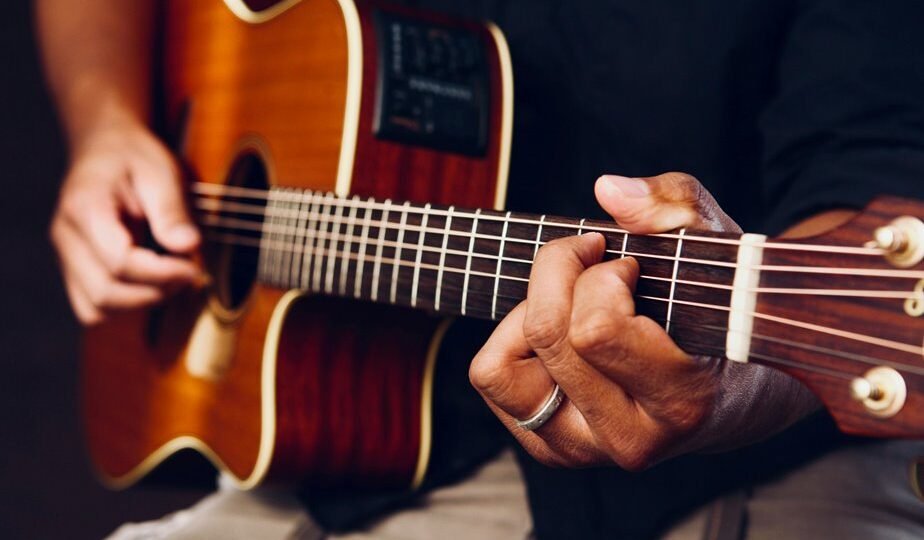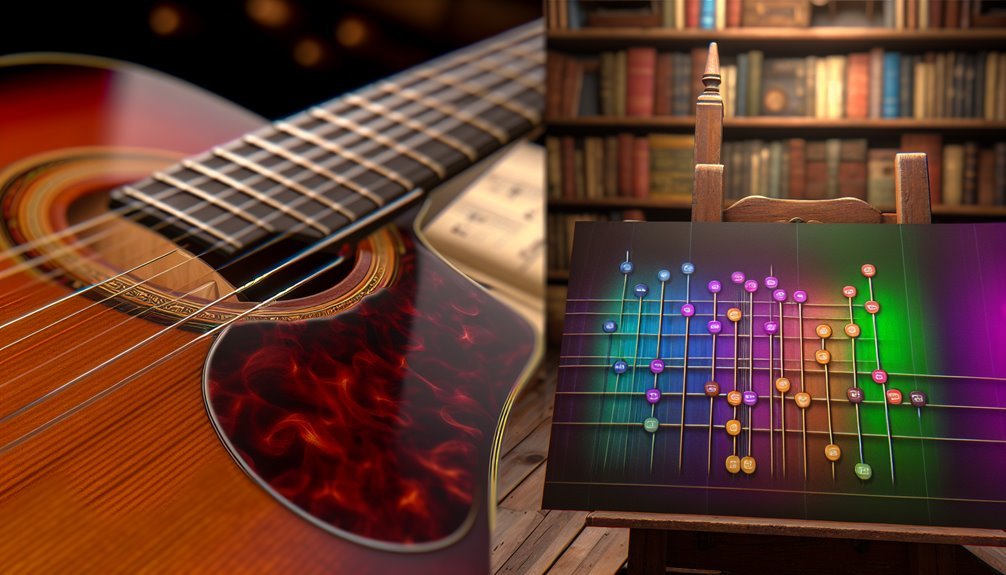
Playing advanced guitar chords isn't just a skill; it's a revolution in sound. I focus on mastering major, minor, and extended chords like 7ths and 9ths to create richness that basic triads lack. I also explore voicing techniques, omitting the 5th for simplicity while keeping the essence of the chords. Power chords can transform into powerful, complex structures with extra notes. Shifting between barre and open chords boosts finger strength. Don't settle for standard progressions; injecting altered chords injects tension and intrigue. Revealing these techniques releases potential you'd never thought possible. And there's so much more to this journey ahead.
Key Takeaways
- Explore Major 7th and Minor 7th chords to enhance your harmonic vocabulary and create richer musical textures.
- Practice barre chords to build finger strength and dexterity, allowing fluid transitions between advanced chord shapes.
- Experiment with voicing techniques by omitting the 5th or using inversions to create diverse tonal qualities in your playing.
- Incorporate extended chords like 9th and 11th to add complexity and depth to your progressions beyond standard triads.
- Utilize online resources and apps for tutorials, practice tools, and community engagement to support your learning of advanced chord techniques.
Understanding Advanced Chord Structures
Why settle for basic chords when you can elevate your playing with advanced chord structures? If you want to truly stand out, you need to master the Major 7th and Minor 7th chords. These chords aren't just variations; they're gateways to rich harmonic landscapes that basic triads can't touch. When I first experimented with these structures, I felt my music transform.
But it doesn't stop there. Chord inversions are your secret weapon. They allow you to rearrange the notes within these chords, revealing a plethora of tonal qualities that can add depth to your progressions.
Want to create tension? Plunge into altered chords, like the b5th or #9th, especially in jazz and contemporary pieces. These modifications will color your music in ways that basic chords simply can't achieve.
Mastering Barre and Power Chords
Mastering barre and power chords isn't just a skill; it's a necessity if you want to sound serious on the guitar.
I can't stress enough how these techniques open up your playing and let you tackle any song in any key.
If you think you can skip this, you're only limiting your potential.
Barre Chord Techniques
Barre chords can feel like a rite of passage for any guitarist, and I'm here to tell you they're worth the struggle. Mastering barre chords is essential for stepping into the domain of advanced guitar chords. It's not just about pressing down multiple strings; it's about creating powerful chord shapes that can be moved up and down the neck.
To truly excel, focus on shifting between barre chords and open chords. This practice builds finger strength and dexterity, making your shifts seamless. Don't shy away from utilizing techniques like false anchor fingers, where one finger stays in place while the others move. This can drastically speed up your shifts and enhance your overall performance.
And let's not forget about using a capo. It's a game changer, allowing you to play in different keys while simplifying barre chord shapes. This way, you can enjoy the richness of sound without the physical strain of pressing all six strings.
Embrace these techniques, and you'll find yourself not just playing chords, but commanding them with confidence. Mastering barre chords is your ticket to revealing a world of musical possibilities.
Power Chord Variations
Power chord variations are your secret weapon for releasing a new level of sound on the guitar. If you're serious about mastering barre chords, you can elevate your power chords beyond their basic two-note structure.
Start by using your index finger to barre the 5th and 4th strings while your ring finger hits the 7th fret of the 3rd string. This creates a solid foundation, but let's push it further.
Want to add depth? Incorporate octaves. Play the root note on the 6th string and the same note two octaves higher on the 4th string. It's a game changer.
Now, let's talk major and minor chords. By adding a third note, you can transform these power chords into sounding chords that resonate with complexity. A simple major or minor third can radically shift the mood of your progression.
Dare to experiment with these variations. You're not just a player; you're an architect of sound.
Mastering these techniques will set you apart in a sea of mediocrity. Embrace the power chord variations, and watch your musical expression soar!
Transitioning Between Chords
After exploring power chord variations, you might be itching to enhance your playing further. Shifting between chords—especially barre and open chords—can be a game changer for your sound.
Let's face it: if you can't switch smoothly, you're limiting your potential.
Here's what I've discovered that works:
- Practice barre chords regularly to build finger strength and dexterity. It's not just about pressing down multiple strings; it's about mastering the technique.
- Use false anchor fingers to facilitate smoother shifts. These little tricks can make your chord changes feel more fluid and less robotic.
- Incorporate chord progressions like I-IV-V that mix barre and power chords. This practice can greatly enhance your ability to switch seamlessly.
Don't be afraid to use a capo. It simplifies barre chord shapes and opens up new keys without the hassle of adjusting finger placements.
Mastering these shifts is vital if you want to elevate your guitar skills. Remember, it's all about the fluidity of your playing. Keep pushing those limits, and watch your progress soar!
Exploring Extended Chords

Extended chords aren't just fancy add-ons; they're game-changers that transform your sound.
When I swap a simple Cmaj7 for a Cmaj9, the richness is undeniable.
If you're not using these chords, you're missing out on a whole world of musical expression.
Understanding Chord Extensions
When diving into advanced guitar playing, understanding chord extensions can truly elevate your sound. Extended chords—those luscious additions beyond the seventh—bring complexity and richness to your music. By adding the 9th, 11th, or 13th, you transform basic triads into intricate harmonic textures. For example, a Cmaj9 chord incorporates C, E, G, B, and D, showcasing how extensions enhance your chord vocabulary.
Here's why you should embrace extended chords:
- Substitution: They can replace standard seventh chords in progressions, adding depth without changing the harmony.
- Simplification: Omitting the fifth degree in voicings can simplify shapes while preserving function.
- Versatility: Familiarity with minor 11ths (like Cm11) and thirteenth chords (like Cmaj13) greatly expands your musical toolkit.
Mastering these concepts isn't just about playing notes; it's about crafting a sound that resonates with listeners.
Practical Applications in Music
Embracing extended chords in your playing isn't just an academic exercise; it's a game-changer for your music. These advanced chords, like major 9ths and dominant 7ths with added 9ths, infuse your guitar chord progressions with a richness that basic triads simply can't match. I often swap simpler chords for these extended options, and the result is a enthralling harmonic texture that elevates my compositions and improvisations.
Here's a quick breakdown of some common extended chords and their applications:
| Chord Type | Example |
|---|---|
| Major 9th | Cmaj9: C-E-G-B-D |
| Dominant 7th | C7: C-E-G-Bb |
| Dominant 9th | C9: C-E-G-Bb-D |
| Minor 7th | Cm7: C-Eb-G-Bb |
| Minor 9th | Cm9: C-Eb-G-Bb-D |
Understanding music theory around these chords lets you omit certain notes while preserving their essence. This flexibility not only simplifies shifts but also deepens your grasp of harmonic relationships. Immerse yourself in the world of extended chords, and watch your music transform into something truly expressive and complex.
Voicing Techniques for Chords
Voicing techniques can drastically change how extended chords resonate in your music. If you're serious about elevating your sound, mastering these techniques is non-negotiable. Extended chords, with their 9th, 11th, or 13th notes, add a harmonic depth that mere triads can't touch.
For example, Cmaj9 (C, E, G, B, D) transforms your playing, while a C9 builds on the C7 with its added richness.
Here are three powerful voicing techniques to reflect upon:
- Omit the 5th: Simplifying fingerings without losing the chord's essence can make changes smoother.
- Utilize inversions: Placing the 3rd in the bass creates a completely different tonal quality, giving you versatility.
- Explore altered chords: These add complexity and character, essential for genres like jazz and funk.
Don't shy away from experimenting. Each voicing you try will deepen your understanding of harmonic relationships and expand your musicality.
In the world of extended chords, the right voicing technique can turn a basic progression into an intricate tapestry of sound. Step up and embrace these strategies; your music will thank you.
Utilizing Alternate Tunings
Releasing the potential of your guitar can be as simple as exploring alternate tunings. If you're a guitar player serious about mastering advanced chords, you need to step beyond standard tuning. Tunings like Drop D or Open G reveal unique chord voicings that standard tuning simply can't offer.
By detuning strings, you can simplify finger placements for complex shapes, allowing you to play intricate chords without the strain.
Don't underestimate the power of alternate tunings like DADGAD or Open D. These tunings are staples in folk and rock music, providing fresh tonalities that can change your songwriting and improvisation.
You'll find that familiar progressions yield unexpected harmonic results, sparking creativity that standard tuning stifles.
However, it's essential to practice shifting between standard and alternate tunings. This versatility is key to maintaining proficiency with advanced chords across various styles.
Embrace the challenge; the rewards are immense. By incorporating alternate tunings into your skill set, you'll not only expand your technical abilities but also revolutionize your sound.
Integrating Fingerstyle Techniques
Integrating fingerstyle techniques into your guitar playing can completely transform how you approach advanced chords. It's not just about strumming; it's about creating a dialogue between melody and harmony.
By mastering fingerpicking patterns, you can enhance the texture of your music, especially in genres like jazz. Here's why you should engage:
- Richer Sound: Fingerstyle brings out the nuances of extended and altered chords.
- Dexterity Boost: Practicing these techniques improves overall control, making complex shifts smoother.
- Unique Flair: Experimenting with harmonics and percussive elements adds an undeniable edge to your performance.
To truly excel, you need to develop thumb and finger independence. This skill is essential for executing complex fingerstyle techniques while maneuvering through advanced chords.
Don't shy away from challenging yourself with intricate patterns; the rewards are immense. As you explore unique voicings and chord shapes, you'll find your playing transforms into something mesmerizing.
Embrace this method, and watch your guitar skills soar to new heights. In the domain of advanced guitar chords, fingerstyle isn't just an addition; it's a revolution.
Crafting Unique Chord Progressions
Crafting unique chord progressions is essential if you want to elevate your guitar playing beyond the ordinary. Don't just settle for tired I-IV-V patterns; explore advanced chord types like maj7, min9, and dominant 7♯9. These chords add the harmonic richness that your progressions truly need.
Start with familiar progressions like II-V-I or I-vi-IV-V as a foundation, then twist them into something fresh. Modulation can be your secret weapon—shift keys mid-progression to create dynamic shifts that keep listeners on their toes.
Analyze famous songs; dissect their chord choices and progressions for inspiration. What makes them resonate? Tension and resolution are your friends.
Use altered chords to build suspense before resolving to stable chords, enhancing emotional impact and leaving your audience craving more.
Applying Music Theory Concepts

While many guitarists shy away from music theory, I believe embracing it can drastically transform your playing. Understanding how major, minor, and dominant chords interact is key to revealing advanced chord possibilities.
Here's how I apply these concepts:
- Learn common chord formulas: Master the major scale formula (W W H W W W H) to build seventh chords and create a strong foundation for complex voicings.
- Experiment with chord inversions: Placing different chord tones in the bass gives you access to extended and altered voicings that elevate your musicality.
- Explore altered chords: Investigate b5th and #9th variations to inject tension and color into your playing, especially in jazz and contemporary styles.
Resources for Continued Learning
I believe that to truly master advanced guitar chords, you need the right resources at your fingertips.
Let's be honest—traditional guitar lessons can only take you so far. With the rise of online platforms like YouTube and dedicated guitar websites, you have access to an endless treasure trove of tutorials that zero in on advanced chord techniques.
Don't underestimate the power of apps like Ultimate Guitar and Chordify; they offer interactive tools that let you practice at your own pace, making them indispensable for serious musicians.
Subscription services, like Guitar Player Magazine, provide curated content filled with lessons and tips that keep your skills sharp and your creativity flowing.
As a guitarist, you should never stop learning, and these resources guarantee you won't.
Community forums and social media groups are also essential. They allow you to share knowledge and gain insights from fellow guitarists, creating a collaborative environment that accelerates your growth.
Finally, consider structured courses that offer a focused exploration into advanced chords, equivalent to multiple weeks of in-person lessons.
If you're serious about mastering your craft, these resources are non-negotiable.
Conclusion
As I've discovered, diving into advanced guitar chords can transform your playing in ways you never imagined. Did you know that over 70% of guitarists feel stuck at basic chords? Don't be one of them! Embrace the challenge of barre chords, alternate tunings, and unique progressions. With practice, you'll unleash a world of musical expression that's both thrilling and rewarding. So grab your guitar, step out of your comfort zone, and start creating something extraordinary!
RELATED POSTS
View all


